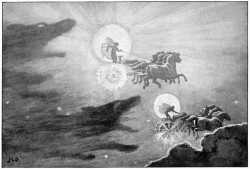Sól
"Sun." The Sun personified, the daughter of Mundilfari, and sister of Máni, according to Vafþrúðnismál. In the same poem she is also called Alfröðull ("Elf-beam").
According to Snorri Sturluson, who bases his account on Vafþrúðnismál and Grímnismál, a certain man named Mundilfari had two children. They were so fair and comely that he named his son Moon and his daughter Sun, and betrothed her to a figure called Glenr. The gods were incensed that Mundilfari had given his children such imposing names and took both children and set them up in the heavens. They caused Sól to drive those horses that drew the chariot of the sun, which the gods had fashioned, for the world's illumination, from the glowing stuff which flew out of Múspell. The horses that pull the chariot, which is hidden behind the glistening shield Svalinn, are named Árvakr and Alsviðr.
Snorri says that the speed by which she moves through the sky is because she is chased by the wolf Sköll. She fears him and he shall take her. Similarly, her brother the moon is chased by the wolf Hati Hróðvitnisson.
Snorri lists Sól among the Ásynjur in Gylfaginning, chapter 35, and she is also found among the list of goddesses in the Nafnaþulur section of Skáldskaparmál.
The eddic poem Alvíssmál contains a number of poetic periphrases for the sun:
|
|
Other kennings for the sun are Daughter of Mundilfari, Sister of the Moon, Wife of Glenr, and Fire of Heaven and of the Air. She and her brother are mentioned in stanza by the eleventh-century skald Skúli Þórsteinsson:
- Glenr's god-blithe Bed-Mate wadeth
- Into the Goddess's mansion
- With rays; then the good light cometh
- Of gray-sarked Máni downward.
❧
Contrary to many other mythologies, the Sun in Norse mythology is female and the Moon is male (probably because of the gender of the nouns: sun is feminine, moon is masculine).
References
Sources
- Alvíssmál, 17.
- Grímnismál, 37-39.
- Gylfaginning, 8, 11, 12, 35.
- Skáldskaparmál, 26.
- Vafþrúðnismál, 23.
- Völuspá, 5.
